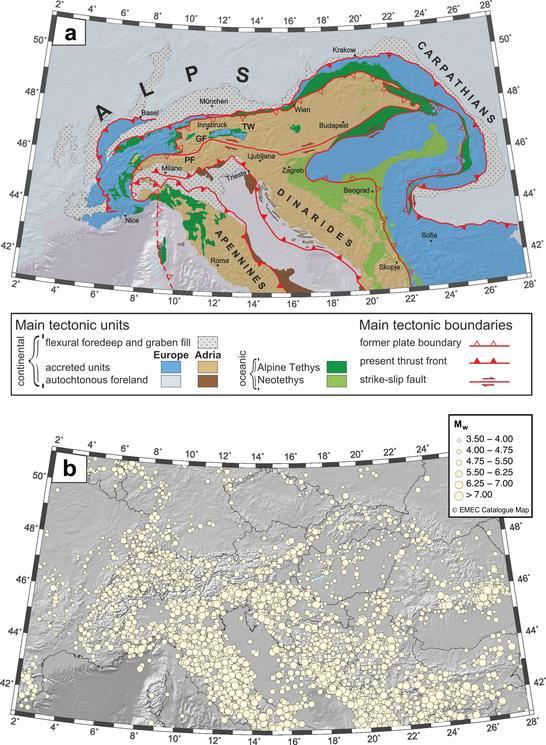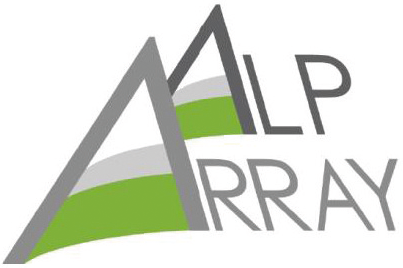The 4D-MB SPP
Priority Programme "Mountain Building Processes in Four Dimensions (MB-4D)" SPP 2017
The Senate of the Deutsche Forschungsgemeinschaft (DFG, German Research Foundation) has established a new Priority Programme entitled “Mountain Building Processes in Four Dimensions” (SPP 2017). The programme is designed to run for six years; the first three-year funding period started in 2017.
Scope: This SPP forms an integral part of the international AlpArray mission to image the structure of the Alps from their surface down to several hundred kilometers depth in the mantle (Fig. 1). It tests the hypothesis that re-organizations of Earth’s mantle during the collision of tectonic plates have both immediate and long-lasting effects on crustal motion, fault kinematics, earthquake distribution and surface evolution. It challenges conventional wisdom by recognizing that linked processes between Earth’s surface and mantle beneath mountain belts can only be explained by integrating 3D imaging of the entire crust-mantle system with geologic observations and modeling to enable us to look both backwards and forwards in time, the 4th dimension. This requires a multi- and interdisciplinary approach that integrates geophysics, tectonics, petrology, geochronology, basin- and surface studies.
Figure 1: (a) Tectonic map of the Alpine chain and its forelands. The Alps result from the collision of two tectonic plates, Europe (blue) and Adria (brown). Red lines mark the main tectonic boundaries; PF - Periadriatic Fault, a major late-orogenic fault system offset by the Giudicarie Fault (GF). TW – Tauern Window. Map compiled from Schmid et al. (2008), Ustaszewski et al. (2008), Schmid & Slejko (2009) and Handy et al. (2010, 2015); (b) Earthquakes of magnitude Mw for the period 1000 to 2006 AD compiled from the EMEC catalogue.
Proposals were invited for four research themes:
Theme 1: Reorganizations of the lithosphere during mountain building will help determine the origin of switches in subduction polarity, particularly to understand how tears in lithospheric slabs nucleate and propagate in time and space. A detailed view of these deep structures with innovative geophysical methods will yield fresh insight into the structure and rheology of the lithosphere, especially as it relates to the response of the surface to changes of lithospheric structure.
Theme 2: Surface response to changes in mountain structure on different time scales will shed new light on the debate over the competition of climate and tectonics during mountain building. It will take on the challenge of distinguishing the effects of deep-seated events (including slab-tearing and –breakoff) and surface processes (e.g., glaciation) on erosion patterns, denudation and uplift rates.
Theme 3: Deformation of the crust and mantle during mountain building will resolve the question of whether deep structure manifests early stages of mountain-building (subduction, collision) or primarily preserves the imprint of later events (indentation, lateral escape). Determining this will constrain rates of structural change in the crust and mantle, and help us understand how subducted continental and oceanic lithosphere are preserved during exhumation to the surface.
Theme 4: Motion patterns & seismicity will identify spatial and temporal patterns of faulting and seismicity to gain an overall motion picture from the present back in time. This theme is aimed at understanding whether current earthquakes and fault motion are related to the deep structure of the Alps or if a new kinematic pattern is already being established in response to current tectonics.
The data base for these research themes is generated in activity fields which entail operation of the AlpArray seismic network covering the Alpine orogen both on land (activity A) and offshore-Liguria (activity B), as well as the deployment of two swaths of dense station networks crossing critically active areas of the Alps - the Apenninic and Southern Alpine orogenic fronts (activity C) and the transition between Eastern and Southern Alps (activity D). Geological studies in well-exposed areas involve integrated structural, petrological, geochronological and/or surface studies (activity E) and are complimented by numerical modeling and tectonic reconstructions to analyse the dynamics of the lithosphere (activity F).
Study Area: The entire orogen is covered by the AlpArray network of seismic stations. Special emphasis is placed on the tectonically most active parts of the orogen where the aforementioned swaths of closely spaced seismometers will be deployed for high-resolution subsurface studies. The focus of the program does not include earthquake prediction or engineering studies.
Linked Investigations: We seek integrated geophysical-geological studies with direct relevance to one or more of the research themes. Therefore, projects proposals are expected to include at least two principal investigators from different disciplines (e.g., seismologist-tectonicist or - petrologist, geochronologist-geodynamics modeler). It is further expected that projects will show how realization of themes is intimately tied to data acquired in one or more of the activity fields. Proposals can be submitted individually (single proposal with several investigators) or in groups (several proposals with clear links to each other).
DFG’s portal “elan”: https://elan.dfg.de
DFG’s forms and guidelines for Priority Programmes: www.dfg.de/spp/formulare
For further scientific information, please contact the Priority Programme’s coordinator:
Prof. Dr. Mark Handy, Tel. 030/838-70311, E-Mail: mark.handy(at)fu-berlin.de
FU Berlin, Institute of Geological Sciences, Malteserstraße 74-100, 12249 Berlin
For administrative and formal inquiries, please contact at the DFG:
Dr. Iris Sonntag, Tel. 0228/885-2253, E-Mail: iris.sonntag@dfg.de
Vanessa Creuzberg, Tel. 0228/885-2320, E-Mail: vanessa.creuzberg@dfg.de



